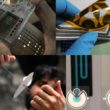
[Image from the researchers/MIT]
The MIT-developed test is a cheap, portable and easy-to-use diagnostic test that could be used in countries where Zika is prominent, but tests that measure viral RNA in the bloodstream are not.
“It’s important to have a single test that can differentiate between the four serotypes of Dengue and Zika, because they co-circulate. They’re spread by the same mosquito,” Kimberly Hamad-Schifferli, associate professor of engineering at the University of Massachusetts at Boston and co-senior author of the paper, said in a press release.
Zika and Dengue are close relatives, and Dengue can often cause false positives in test results. The new diagnostic test doesn’t not cross-react with Dengue.
Zika virus is spread through the bite of an infected mosquito. According to the CDC, there have been 288 reported cases of Zika in the U.S. this year as of Oct. 4.
One of the other challenges of diagnosing Zika is that a lot of the tests are based on antibodies that interact with NS1, a viral protein found in the bloodstream of Zika patients. However, a lot of other viruses in the same family have the similar versions of NS1 and can show false positives.
To make the tests more precise, the researchers found antibodies that could interact with only NS1 proteins created by the Zika virus and antibodies that are specific to NS1 from the four different strains of Dengue virus.
The researchers exposed mice to both Zika and Dengue to test their method and started to screen the antibodies that formed in pairs against all flavivirus versions of NS1 protein. Doing so allowed the researchers to figure out which pairs of antibodies reacted with one type of NS1 protein but not the others.
“We knew by informatics analysis that if we looked enough, and we teased out the repertoire of the B cells of these animals, we would eventually find those antibodies,” research scientist Irene Bosch said. “We were able to tease out the very few antibodies within the repertoire that would give you uniqueness in the detection.”
When the researchers found the pairs, they created five different tests for each virus type. Strips of paper were coated with an antibody from each pair while the other antibody was attached to gold nanoparticles. The paper strip gets dipped into a solution of nanoparticles after adding the patient’s blood. If NS1 is present in the sample, it attaches to antibodies on the paper strip and the nanoparticle antibodies. A colored spot will appear on the strip after about 20 minutes.
Currently, the process involves using five test strips for each sample to test each virus. The researchers are currently working on a way to narrow it down to one strip for all five tests.
The researchers found that the results gathered from the paper method to be compared to the ones from a polymerase chain reaction test that detect viral RNA in the bloodstream. However, these tests are more advanced and aren’t typically used in Zika is most prominent because they need trained personnel and lab equipment to be performed.
“Since conventional methods require a great deal of time for sample collection and diagnostics, this inexpensive, paper-based, rapid diagnostic will be very useful for the diagnosis of many infectious diseases,” said Luke Lee, an associate president of the National University of Singapore and director of the Biomedical Institute for Global Health Research and Technology in Singapore.
The MIT-developed test is not the first paper-based diagnostic tool created for developing countries. Researchers have created foldable paper microscopes, paper centrifuges and MIT also recently developed a paper-based test for diagnosing Ebola.
“When we have traveled to the places where these viruses are problems, the people there unanimously say that they need more surveillance. They need to know which viruses are circulating in their environments,” Lee Gehrke, senior author of the study, said.
The researchers suggest that the knowledge used to develop this test could work toward developing tests for other viruses in the future.
“By already screening this group of antibodies that we have against all these antigens we have, like West Nile, we already know how well they react. So that’s information we could use in the future to develop additional tests that can be used to detect other emerging viruses,” Gehrke said.
Now, the researchers are working on creating a diagnostic test for Powassan virus that is carried by ticks that also carry Lyme disease.
The research was published in the journal Science Translational Medicine and was funded by the U.S. Public Health Service, the Science, Technology and Innovation Fund of Colombia and a Tata Center for Technology and Design fellowship.
(See the best minds in medtech live at DeviceTalks West, Dec. 11–12 in Orange County, Calif.)







